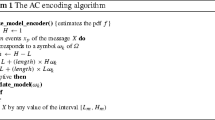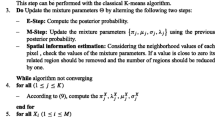Abstract
In this paper, we propose a new approach for a block-based lossless image compression using finite mixture models and adaptive arithmetic coding. Conventional arithmetic encoders encode and decode images sample-by-sample in raster scan order. In addition, conventional arithmetic coding models provide the probability distribution for whole source symbols to be compressed or transmitted, including static and adaptive models. However, in the proposed scheme, an image is divided into non-overlapping blocks and then each block is encoded separately by using arithmetic coding. The proposed model provides a probability distribution for each block which is modeled by a mixture of non-parametric distributions by exploiting the high correlation between neighboring blocks. The Expectation-Maximization algorithm is used to find the maximum likelihood mixture parameters in order to maximize the arithmetic coding compression efficiency. The results of comparative experiments show that we provide significant improvements over the state-of-the-art lossless image compression standards and algorithms. In addition, experimental results show that the proposed compression algorithm beats JPEG-LS by 9.7 % when switching between pixel and prediction error domains.




Similar content being viewed by others
References
Abramson N (1963) Information theory and coding. McGraw-Hill Book Company, Inc., New York
Alcaraz-Corona S, Rodriguez-Dagnino RM (2010) Bi-level image compression estimating the markov order of dependencies. IEEE J Sel Topics Signal Process 4(3):605–611
Auli-Llinas F (2011) Stationary probability model for bitplane image coding through local average of wavelet coefficients. IEEE Trans Image Process 20(8):2153–2165
Burrows M, Wheeler DJ (1994) A block-sorting lossless data compression algorithm, Tech. Rep., digital equipment corporation, Palo Alto, California
Carpentieri B (1997) A new lossless image compression algorithm based on arithmetic coding. In: Proceedings of the 9th international conference on image analysis and processing-volume II, pp 54–61
Dempster AP, Laird NM, Rubin DB (1977) Maximum likelihood from incomplete data via the em algorithm. J R Stat Soc Ser B 39(1):1–38
Howard PG, Vitter JS (1993) Fast and efficient lossless image compression. In: Proceedings 1993 data compression conference. Mars, IEEE Computer Society Press, pp 351–360
Howard PG, Vitter JS (1994) Arithmetic Coding for Data Compression. Proc IEEE 82(6):857–865
Jeff Wu CF (1983) On the convergence properties of the EM algorithm. Ann Stat 11(1):95–103
Kullback S, Leibler RA (1951) On information and sufficiency. Ann Math Stat 22:49–86
Kuroki N, Manabe T, Numa M (2004) Adaptive arithmetic coding for image prediction errors. In: Proceedings of IEEE international symposium on circuits and systems (ISCAS 04), vol III, pp 961–964
Langdon GG (1984) An Introduction to Arithmetic Coding. IBM J Res Dev 28:2
Masmoudi A, Masmoudi A (2013) A new arithmetic coding model for a block-based lossless image compression based on exploiting inter-block correlation. Sig Image Video Process 1–7
Masmoudi A, Puech W, Bouhlel MS (2010) Efficient adaptive arithmetic coding based on updated probability distribution for lossless image compression. J Electron Imaging 19(2):023014
Matsuda I, Shirai N, Itoh S (2003) Lossless coding using predictors and arithmetic code optimized for each image. In: Proceedings of international workshop visual content processing and representation, vol 2849, pp 199–207
Mclachlan GP, Peel D (2000) Finite mixture models, wiley series in probability and statistics. Wiley-Interscience, 1st edn
Minoo K, Nguyen T Q (2009) Entropy coding via parametric source model with applications in fast and efficient compression of image and video data. In: DCC’09
Moffat A, Neal RM, Witten IH (1998) Arithmetic coding revisited. ACM Trans Inf Syst 16(3):256–294
Rubin F (1979) Arithmetic stream coding using fixed precision registers. In: Data compression conference, pp 672–675. IEEE transaction on information theory
Salomon D (2007) Data compression the complete reference fourth edition. Springer
Shannon CE (1948) A mathematical theory of communication. Bell Syst Tech J 27:379–423
Taubman DS, Marcellin MW (2002) JPEG2000: image compression fundamentals; standards and practice. Springer
Teuhola J (2011) Nonblock coding of binary sources by probabilistic enumeration. IEEE Trans Inf Theory 57(9):6170–6179
Weinberger MJ, Seroussi G, Sapiro G (2000) The LOCO-I lossless image compression algorithm: principles and standardization into JPEG-LS. IEEE Trans Image Process 9(8):1309–1324
Witten IH, Neal RM, Cleary JG (1987) Arithmetic coding for data compression. Commun ACM 30(6):520–540
Wu X, Memon N (1996) CALIC - context based adaptive lossless image codec. IEEE Int Conf Acoust Speech Sig Process 4:1890-1893
Wu J, Xu Z, Jeon G, Zhang X, Jiao L (2013) Arithmetic coding for image compression with adaptive weight-context classification. Sig Process Image Commun 28(7):727–735
Ye H, Deng G, Devlin JC (2002) Parametric probability models for lossless coding of natural images. In EUSIPCO, pp 514–517
Zhang L, Wang D, Zheng D (2012) Segmentation of source symbols for adaptive arithmetic coding. IEEE Trans Broadcast 58(2):228–235
Zhao DY, Samuelsson J, Nilsson M (2008) On entropy-constrained vector quantization using gaussian mixture models. IEEE Trans Commun 56(12):2094–2104
Author information
Authors and Affiliations
Corresponding author
Rights and permissions
About this article
Cite this article
Masmoudi, A., Puech, W. & Masmoudi, A. An improved lossless image compression based arithmetic coding using mixture of non-parametric distributions. Multimed Tools Appl 74, 10605–10619 (2015). https://doi.org/10.1007/s11042-014-2195-8
Received:
Revised:
Accepted:
Published:
Issue Date:
DOI: https://doi.org/10.1007/s11042-014-2195-8




